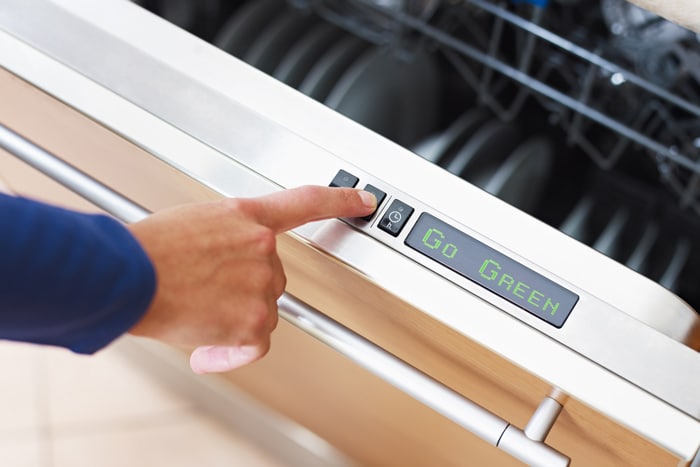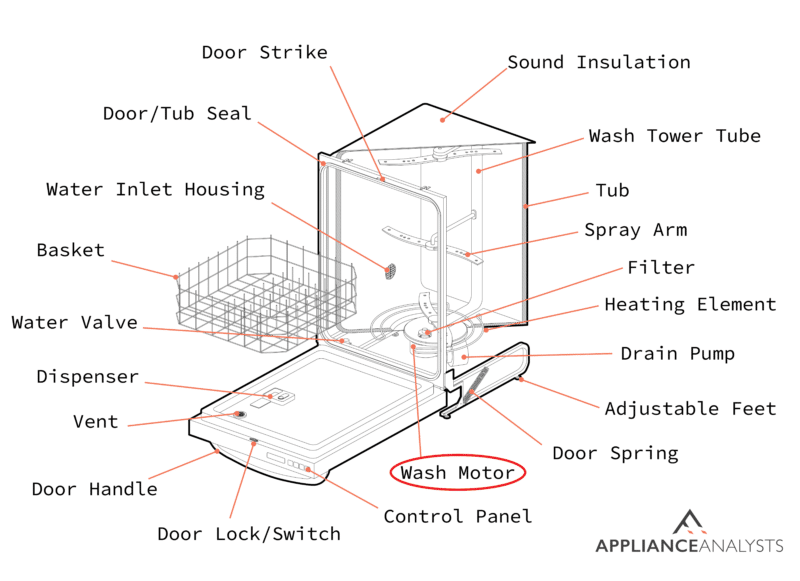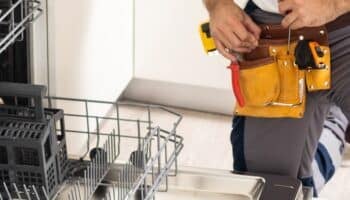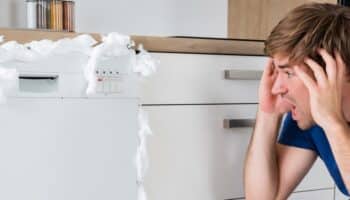We've independently reviewed this article to make sure it's as accurate as we can make it.
To find out more about our article creation and review process, check out our editorial guidelines.
Is your dishwasher stubbornly refusing to use more than one cycle, and it’s driving you up the wall?
You’re not alone! Thousands of people have to deal with faulty dishwashers and other appliances daily.
I know having your dishwasher be stuck on one cycle can be annoying, especially if you have a huge pile of dirty dishes waiting to be cleaned.
Luckily, you came to the right place for answers. In this article, I’ll walk you through the 4 common causes for a dishwasher that won’t change cycle, as well as simple ways to address each one.
I’m sure that in no time, you’ll have your dishwasher rolling and your feet up on the couch.
Ready to go? Let’s dive in!

Fixing A Dishwasher Stuck On One Cycle
Your Dishwasher Needs a Reset
If you want to try and clear the stuck cycle straight away, you‘ll want first to try resetting your dishwasher to see if any issues can be fixed in the software before you start repairing or replacing parts.
The simplest way to reset your dishwasher is to switch off the power via your circuit breaker. Give it 5 minutes or so, then turn the power back on. Hopefully, that’ll wipe any current memory from the dishwasher and set it back to functioning normally.
If resetting your dishwasher via your circuit breaker fails, you could always try a software reset. You can reset your dishwasher by following the reset instructions in your owner’s manual.
Don’t have your manual handy? That’s okay! You can check out our guide to finding any product manual online:
Once you have the specific instructions you need, go ahead and reset your dishwasher. Taking the time to go through the possible problems is the best way to start to figure out why our dishwasher is stuck on one cycle and what you can do about it.
Water Temperature Issues
In most cases, when your dishwasher is stuck on one cycle, it’s either a rinse or a cleaning one. The way that a dishwasher works is that the water comes into the machine and is then held at the basin at the bottom of the dishwasher.
The dishwasher has to have a specific set or routine that it has to go through to move from one step to the next. All the functions of your dishwasher are tied to the computer that tells the dishwasher what to do next and how to progress.
Your dishwasher is likely to be stuck in wash mode in cases where the water is not hot enough, or the thermostat is not working properly. If the water is not at the right temperature, it will not progress to the next cycle, and will not move on to wash the dishes.
Most dishwashers need the water in the dishwasher to be between 120- and 130 degrees Fahrenheit, but if the water does not reach that temperature or falls within that range, the dishwasher will stay in the same cycle in the hopes that the water will come up to the temperature.

If your dishwasher does not have the right temperature water, it is not going to wash properly, and it is not going to move from cycle to cycle. You can check the water temperature by looking at what the thermostat of your water heater is set at. If you cannot do this, you can run your dishwasher and then use a thermometer to see what the water temperature is.
You can also adjust the water heater to make the water hotter.
A Faulty Thermostat
Another issue you might be dealing with is that the thermostat of the dishwasher is not working and therefore does not allow the dishwasher to move from one cycle to another. The thermostat works to help keep the water at the right temperature and also to help make sure that the hot air used to dry the dishes after washing is the right temperature. You can check the thermostat in the dishwasher to determine if it is working or not.
In case it’s not, you’ll have to replace it. Don’t worry, though – it’s pretty simple!
The thermostat is located at the bottom of the dishwasher. Start by turning off the electricity to the dishwasher. You then want to remove the dishwasher kick panel. After that, you can look under the dishwasher and locate the thermostat; you can then refer back to the owner’s manual to see which thermostat will be measuring the temps.
If you want to get any replacement part – or see how much one would cost – click to enter your model number in the search bar below. Our partners at AppliancePartsPros stock almost every part with free guides on how to install them.

Timer Issues
Yet another element that could be causing your dishwasher to be stuck on a wash cycle is a bad timer. The timer controls the electricity going into the appliance, as well as how long it will be supplied to it during each cycle. If the timer is not working properly, it is not going to supply the right amount of electricity at the right time to the machine, which will make it impossible to switch from one cycle to another.
To check the timer, you should turn off the electricity to the unit, then pull off the dishwasher’s control panel. You then need to remove the outer door from the inner door; the timer is going to be located between the inner and exterior doors. If you suspect the timer is not working, now is the time to replace it. Remove the old timer and hook up a new one per the instructions included with the new one.
After you have replaced the timer, you should try the dishwasher again and see if it works. If it doesn’t, that’s ok; there are more solutions to try below.
Float Switch Issues
Another element that could be causing your dishwasher to be stuck on wash cycle is the float switch. The float switch is a small switch that measures the amount of water in the machine. If the float does not show the appropriate amount of water in the dishwasher, it will not move from one cycle to another. If the float is not activated and does not show that there is enough water in the dishwasher, it will stay in the wash cycle longer to try and compensate for what it feels is a lack of water.
You can use a multimeter to test and see if your float is working and to determine if it needs to be replaced or if there is another issue that requires your attention.
When Is It Time to Replace Your Dishwasher?
It’s no secret that older dishwashers used to be more durable than newer models. If you have an older model, you can easily expect it to last anywhere between 12-15 years, whereas if it’s a newer machine, you’ll likely need to have it serviced before its 5th year.
Now, these are simply board estimations, as you can encounter issues much sooner or much later than that depending on how well you give the appliance maintenance, and how well you follow your manufacturer’s instructions.
To make things clearer, here are some telltale signs I recommend you keep an eye out for to know when your dishwasher needs replacing.
- Age: In my experience, if your dishwasher is approaching a decade and a half, you’re not only missing out on features and energy efficiency but also on performance. Provided your trusty appliance is on the older side, check out our guide on the 7 best times to buy a dishwasher on sale.
- Buzzing Motor Sound: A buzzing sound coming from your dishwasher will always be related to a faulty motor. You can let the appliance run with a damaged motor until it doesn’t work anymore, but once it fails completely, you’ll have to call a technician for repairs. In a scenario like this, I typically don’t recommend paying more than half the price of a new dishwasher for repairs.
- Poor cleaning performance: When paired with age and loud sounds, poor cleaning performance is yet another sign that your dishwasher needs repairing or replacing. You can get an estimate for the repairs after a professional runs an initial diagnosis, but if the repairs are too expensive, you’re better off going shopping for a new model.
- Constant Repairs: If you’ve had to repair your trusty dishwasher more than 3 times in a single year, its need for servicing and attention is unlikely to go down in frequency. In cases like these, you’re clearly in a position where replacing the appliance is necessary.

Conclusion
That about covers it!
With proper care and the right attention, a good dishwasher can last for decades and be a great investment for your home.
I hope that this article has helped you better understand and address the most common issues that are affecting your dishwasher and keeping it stuck in a single cycle. Remember to start with a reset, then go through the different issues that are present so that you can pinpoint the source of the situation before you consider replacing your entire machine.
Thank you very much for reading, I hope this article was helpful and answered your most burning questions. If so, please check out our other incredible resources below and consider subscribing to our newsletter.
Have a wonderful day.
-Craig.








